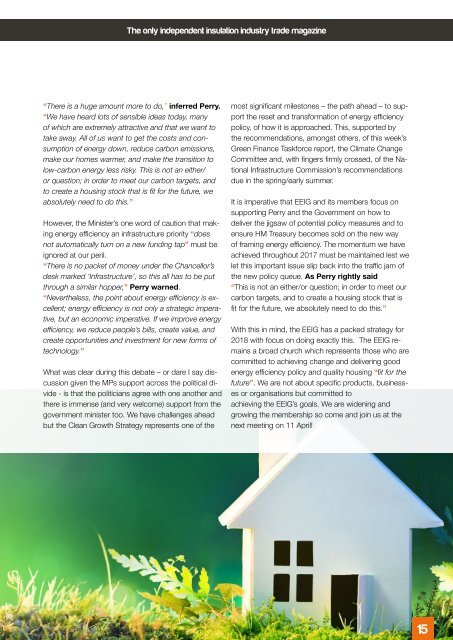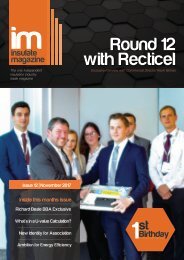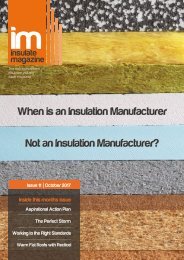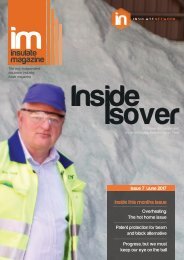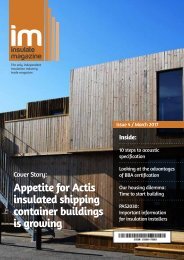Insulate Magazine Issue 17
You also want an ePaper? Increase the reach of your titles
YUMPU automatically turns print PDFs into web optimized ePapers that Google loves.
The only independent insulation industry trade magazine<br />
“There is a huge amount more to do,” inferred Perry.<br />
“We have heard lots of sensible ideas today, many<br />
of which are extremely attractive and that we want to<br />
take away. All of us want to get the costs and consumption<br />
of energy down, reduce carbon emissions,<br />
make our homes warmer, and make the transition to<br />
low-carbon energy less risky. This is not an either/<br />
or question; in order to meet our carbon targets, and<br />
to create a housing stock that is fit for the future, we<br />
absolutely need to do this.”<br />
However, the Minister’s one word of caution that making<br />
energy efficiency an infrastructure priority “does<br />
not automatically turn on a new funding tap” must be<br />
ignored at our peril.<br />
“There is no packet of money under the Chancellor’s<br />
desk marked ‘Infrastructure’, so this all has to be put<br />
through a similar hopper,” Perry warned.<br />
“Nevertheless, the point about energy efficiency is excellent;<br />
energy efficiency is not only a strategic imperative,<br />
but an economic imperative. If we improve energy<br />
efficiency, we reduce people’s bills, create value, and<br />
create opportunities and investment for new forms of<br />
technology.”<br />
What was clear during this debate – or dare I say discussion<br />
given the MPs support across the political divide<br />
- is that the politicians agree with one another and<br />
there is immense (and very welcome) support from the<br />
government minister too. We have challenges ahead<br />
but the Clean Growth Strategy represents one of the<br />
most significant milestones – the path ahead – to support<br />
the reset and transformation of energy efficiency<br />
policy, of how it is approached. This, supported by<br />
the recommendations, amongst others, of this week’s<br />
Green Finance Taskforce report, the Climate Change<br />
Committee and, with fingers firmly crossed, of the National<br />
Infrastructure Commission’s recommendations<br />
due in the spring/early summer.<br />
It is imperative that EEIG and its members focus on<br />
supporting Perry and the Government on how to<br />
deliver the jigsaw of potential policy measures and to<br />
ensure HM Treasury becomes sold on the new way<br />
of framing energy efficiency. The momentum we have<br />
achieved throughout 20<strong>17</strong> must be maintained lest we<br />
let this important issue slip back into the traffic jam of<br />
the new policy queue. As Perry rightly said<br />
“This is not an either/or question; in order to meet our<br />
carbon targets, and to create a housing stock that is<br />
fit for the future, we absolutely need to do this.”<br />
With this in mind, the EEIG has a packed strategy for<br />
2018 with focus on doing exactly this. The EEIG remains<br />
a broad church which represents those who are<br />
committed to achieving change and delivering good<br />
energy efficiency policy and quality housing “fit for the<br />
future”. We are not about specific products, businesses<br />
or organisations but committed to<br />
achieving the EEIG’s goals. We are widening and<br />
growing the membership so come and join us at the<br />
next meeting on 11 April!<br />
15


